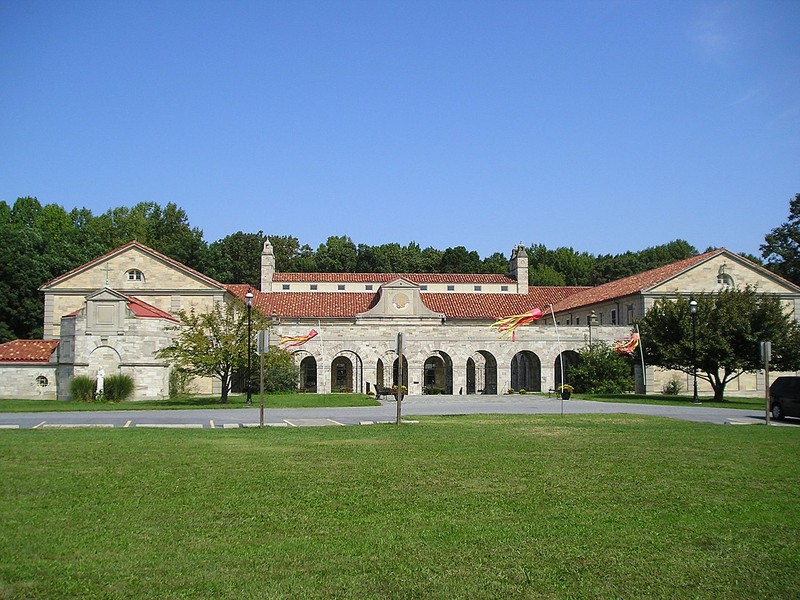The Shrine of St. Anthony
Introduction
Text-to-speech Audio
The Shrine of St. Anthony of was established in 1928 to honor Saint Anthony of Padua, a Portuguese Franciscan friar canonized in 1232. The Shrine is operated by a the Conventional Franciscan Friars and serves as a novitiate, retreat center, and a Catholic pilgrimage site. The Shrine also offers mass services, workshops, seminars, and tours. The grounds feature trails, a garden, a grotto to Our Lady of Lourdes, a Marian grotto, an outdoor shrine to St. Maximilian Kolbe, and a rose garden. In addition to the shrine building, which was built in 1931, the site also includes another notable structure, Carrollton Hall. Listed on the National Register of Historic Places, the shrine was erected in 1832 by Charles Carroll of Carrollton (1737-1832) and as of August 2022, the Friars are planning to restore it into a meeting, retreat, and exhibit space. Carroll was the only Catholic signer of the Declaration of Independence and one of the first two U.S. senators from Maryland.
Images
The Shrine of St. Anthony was built in 1932 and serves as a pilgrimage site, retreat center, and novitiate.

Carrollton Hall was built in 1832 and is listed on the National Register of Historic Places.
_-_outbuilding_1.jpg)
Backstory and Context
Text-to-speech Audio
The history of the shrine property dates to 1700 when Carroll's father, Charles Carroll of Annapolis (1702-1782), received 10,000 acres in present-day Howard County. The property became the Doughoregan Manor and it features a large plantation house that is now a National Historic Landmark (and a separate Clio entry). Carroll gave his granddaughter, Emily Caton MacTavish, 1,000 acres as a wedding present in 1831. This tract of land was named "Folly's Quarter." At the time, "folly" referred to as a hillside residence shaded by trees and not as a mistake.
Carrollton Hall was built in Folly's Quarter. Unfortunately, Carroll died not long before it was completed; he was 95 years old. Designed by Baltimore architect William F. Small in the Greek Revival style, it was built of stone and features two porticos with Doric columns and a cupola on the roof. Inside, the house features vaulted ceilings, symmetrical molding with bull's eye corner blocks, marble mantels, and plaster trim.
Emily and her husband, John MacTavish, put the property (and their enslaved workers) up for sale in 1842. The reasons why are unclear but it is possible that Emily was busy taking care of her parents at another property and did not spend much time at Carrollton Hall. They did not find any buyers, however. It was finally sold to their son, Charles Carroll MacTavish, in 1850. In 1864, he sold it to a man named Charles M. Dougherty. Maryland Governor John Lee Carroll acquired the property in the early 1880s. His son, Charles Carroll, eventually inherited the property and named the house Carrollton Hall.
Two owners later, the property, which by then was 236 acres, was sold to the Franciscan Friars in 1928. The Friars built the current shrine building in 1931 since Carrollton Hall was too small. The shrine was designed as miniature version the Sacro Convento friary in Asisi, Italy. In 1995, the shrine received a relic from the Basilica of Saint Anthony of Padua. The Archbishop of Baltimore designated the shrine as the official archdiocesan shrine to St. Anthony in 2005. In 2014, Carrollton Hall was added to the National Register of Historic Places. It has been known as the Carrollton Hall Cultural Center since 2015.
Sources
Heine, Fr. Michael. "Announcing the Friars' Campaign for Carrollton Hall." Accessed August 24, 2022. http://www.carrolltonhall.org/Carrollton%20Hall%20newsletter.pdf.
"History." The Shrine of St. Anthony. Accessed August 24, 2022. https://www.shrineofstanthony.org/history.
Short, Ken. "Carrollton Hall." National Park Service - National Register of Historic Places Nomination Form. December 16, 2014. https://mht.maryland.gov/secure/medusa/PDF/NR_PDFs/NR-1550.pdf.
Both images via Wikimedia Commons: https://commons.wikimedia.org/wiki/Category:Shrine_of_St._Anthony_(Ellicott_City,_Maryland)
